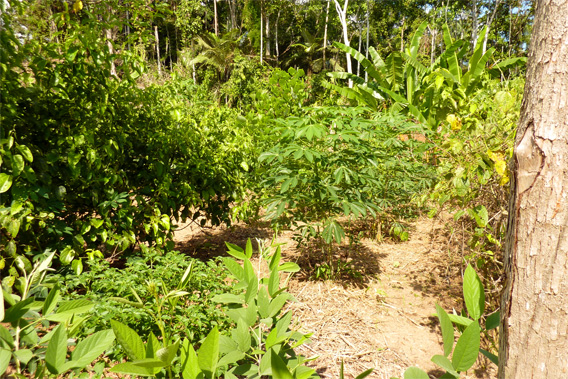Farming Goes High-Tech in the Amazon
www.fastcoexist.com
In the Amazon, technology can be difficult. The high heat and humidity prevents many machines from working.
“To be honest, anything above a combustion engine is ‘technologically advanced’ in the area of Peru we’re working in,” said Rick Pickett, a volunteer with Eco Ola, a company trying to promote and sell Amazonian super-foods while maintaining biodiversity and helping local farmers.
Eco Ola has nine hectares of land, on which they are using sustainable farming techniques like polycultures (using more than one plant species in the same area), alley cropping (growing an agricultural crop simultaneously with a long-term tree crop to provide annual income while the tree crop matures), and rotating crops.
Most farmers in the Loreto region of Peru practice simple agriculture. They plant cassava, plantains, and papaya. In low areas with higher fertility, or in slash-burn areas, they’ll also plant rice or corn. The concepts of soil maintenance and creation are virtually non-existent, says Pickett.
Pickett says that the land can’t hold up to such heavy use. “They exhaust the fertility and life of the soil and then move on to new forest for clearing, due to the inherent fragility of the nutrient cycle in the humid tropics,” he said. Ninety-percent of the organic matter lives in the leaf litter and biomass of the forest, with the remaining 10% residing in the soil. With slashing-and-burning, followed by heavy nutrient feeding crops, the soil’s nutrients are quickly absorbed and leached by the heat and high rainfall.
With such a fragile infrastructure and environment, the company has taken on a wide variety of land management strategies to keep the land use sustainable. Pickett uses three-dimensional modeling software to diagram natural features such as marshes or water catchment formations. He also uses GPS to mark out the land features and crop placements to get an accurate projection of production and identify weak areas for organic fertilizer treatment. He said the technology can project shading patterns, which helps with plant organization, especially for shade-loving trees.
Pickett walked around the farm with a hand-held GPS, inputting information about plant health, changes in topography, and land quality. The map was then overlaid with satellite information, and each type of plant was added to the terrain model based on its needs–creating a three-dimensional farm map.
Many of the neighboring farms have started to work with Eco Ola to lease the use of their land with new methods and technology. “The benefit to the farmers is that we offer fair and consistent pricing for production, access to global markets, and education about sustainable agricultural practices and technologies,” said Pickett. Modeling offers the benefit of examining root interactions, shade cover, and maturation sizes among plant groupings. Every farming site needs to take into account the site specifics, but developing model groupings and associations can work for multiple sites within similar environments.
Technology doesn’t always have to be silicon-based for it to be high-tech and beneficial to the farmers and the company. “One of the best things I’ve re-introduced was the whiteboard,” said Pickett.
Permaculture: a path toward a more sustainable Amazon?
www.mongabay.com
May 03, 2012
 An Eco-Ola permaculture plot with yuca, beans, sacha inchi, bananas, charapitas, herba luisa, and moringa in the Peruvian Amazon.
An Eco-Ola permaculture plot with yuca, beans, sacha inchi, bananas, charapitas, herba luisa, and moringa in the Peruvian Amazon.
Communities living in and around tropical forests remain highly dependent on forest products, including nuts, resins, fruit and vegetables, oils, and medicinal plants. But relatively few of these products have been successfully commercialized in ways that generates sustained local benefits. When commercialization does happen, outsiders or a few well-placed insiders usually see the biggest windfall. Large-scale exploitation can also lead to resource depletion or conversion of forests for monoculture-based production. The ecosystem and local people lose.
The situation can be even worse in landscapes that have been completely deforested and subsequently degraded by poor land management. Rural small-holders may suffer from poor soils, which hurt yields and increase dependence on expensive fertilizers and other chemical inputs. Lack of profitability may cause some to move to urban areas or seek jobs on cattle ranches and industrial farms. Others may follow the forest frontier, clearing land for short-term use before moving deeper into rainforest areas. The approach is inherently unsustainable.
This wasn’t always the case. Ancient Amazonians utilized methodologies like permaculture and terra preta (biochar) to farm while enriching soils and even enhancing biodiversity.
A group in Peru is now working to embrace elements of this lost approach and in the process reduce small-holder deforestation, restore the quality of degraded tropical soil, and diversify and strengthen rural livelihoods. Eco Ola, a Peru-based organization founded by William Park and Carla Noain, has developed a community training center in the Peruvian Amazon to train people to learn how to improve soil in a polyculture/agroforestry system. Permaculture essentially mimics the form and structure of a natural forest, with a diverse array of species including a canopy of timber and fruit trees; an understory of cacao, bananas and species; and a shrub layer of herbs, legumes, and peppers. Eco Ola also runs a small non-wood forest products venture with indigenous communities.
William talked about his work in a May 2012 interview with mongabay.com.
See the Full Interview on Mongabay
Eco Ola Project: A Model For Modern Agroecological Farming
The Organic View
June 11, 2012
 Sustainable agriculture is the practice of farming using principles of ecology, the study of relationships between organisms and their environment. Eco Ola is a farm located near Iquitos, Peru at the headwaters of the Amazon River that uses permaculture to produce food. Eco Ola’s mission is to break the cycle of resource depletion and poverty plaguing the Peruvian Amazon through the implementation of permaculture in conjunction with the local communities. The destructive cycle starts with logging; uncontrolled slash and burn; followed by cattle grazing; then abandonment of the land for newly exploited areas. Towards this goal they have developed a polyculture system that includes a myriad of community staples such as yuca, bananas, and beans; regional crops: cocona, camote, peppers, achiote, and lemon grass; and the export crops sacha inchi and cacao. This diversity of crops mitigates yield and market risks while restoring degraded land and building community self reliance. Eco Ola understands the importance of proving that agroecological farming systems work and provide a real alternative to industrial farming. All of their design work is geared toward scalability and the inclusion of additional communities to turn the negative feedback cycles into positive ones. A key facet of this is providing people with access to healthy foods that are truly sustainable. Consumer choice can only be an agent of change when real alternatives are made available and people can make informed buying decisions.
Sustainable agriculture is the practice of farming using principles of ecology, the study of relationships between organisms and their environment. Eco Ola is a farm located near Iquitos, Peru at the headwaters of the Amazon River that uses permaculture to produce food. Eco Ola’s mission is to break the cycle of resource depletion and poverty plaguing the Peruvian Amazon through the implementation of permaculture in conjunction with the local communities. The destructive cycle starts with logging; uncontrolled slash and burn; followed by cattle grazing; then abandonment of the land for newly exploited areas. Towards this goal they have developed a polyculture system that includes a myriad of community staples such as yuca, bananas, and beans; regional crops: cocona, camote, peppers, achiote, and lemon grass; and the export crops sacha inchi and cacao. This diversity of crops mitigates yield and market risks while restoring degraded land and building community self reliance. Eco Ola understands the importance of proving that agroecological farming systems work and provide a real alternative to industrial farming. All of their design work is geared toward scalability and the inclusion of additional communities to turn the negative feedback cycles into positive ones. A key facet of this is providing people with access to healthy foods that are truly sustainable. Consumer choice can only be an agent of change when real alternatives are made available and people can make informed buying decisions.
Tune in to this segment of The Organic View Radio Show, as host, June Stoyer is joined by special guest, the founder of Eco Ola, William Park, to talk about what it takes to create a truly sustainable farm while maintaining harmony with the community. Stay tuned!




